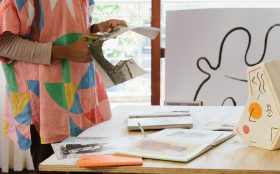Image via freeimages.com
Artists and arts organisations trying to build their profile, expand their audience, promote their shows and publicise their achievements have more tools at their disposal than ever before.
Social media – ubiquitous, immediate and free – is in many ways a dream come true for a highly creative professionals who in bygone eras relied on the networks of wealthy patrons and conservative academies to spread word about their work.
But in a social media landscape saturated with artistic talent from across the globe, how can local artists cut through the clutter with communication that inspires and engages?
The key is taking a strategic approach from the start, according to Tracey McIrvine, Visual Arts Manager at Gasworks Arts Park in Melbourne and manager of 16 professional artists.
McIrvine said successful artists not only have a mature body of work, they havea strategic plan for promoting and marketing it. They know precisely what they’re trying to achieve with every tweet, Facebook post and Instagram video.
‘Content is king, distribution is queen,’ McIrvine said. ‘Before you can actually sell yourself or send out a media release – who are you? What are you trying to pitch? You have to clarify that. What’s in it for your audience?’
Good digital marketing requires artists to create valuable content with and for their audience, not simply to “sell stuff”. Using social media like Facebook means creating real, two-way conversations and building genuine relationships so that people want to discuss and share your work.
Here are her tips:
DO
Do define the image you want to project. Decide why you’re using Facebook and focus on that. What do you want people to know about you and your art?
Do treat others as you would in real life.
Do update daily, or at least several times a week.
Do use the same name and username across all social media. Aliases that aren’t widely known make you hard to find.
Do give people good reasons to revisit your page. Use narratives, themes, questions and opinions. Talk candidly about your art, daily challenges, inspirations, triumphs and perspectives, and encourage their questions and comments.
Do let people behind the scenes. Post about your time in the studio, the progress of particular works, your process, the purpose of your art, and your broader mission in life. Use videos and images.
Do make it about more than you. Give people something to be a part of, learn from, relate to and share.
Do encourage comments and shares rather than just likes. Respond when people comment and keep the conversation going. On Facebook comments and shares appear in friends’ news feeds, exposing your posts to new people.
Be generous in commenting other people’s posts and discussions. Like and share their art and maybe, very occasionally, sent them a short complimentary message.
Understand that the purpose of social media is not to pile up friends for no reason, but to initiate and hopefully establish mutually beneficial relationships.
DON’T
Don’t post personal stuff. This is business so forget the selfies, cat videos and quizzes unless they relate to your art.
Don’t post unflattering photos, unrelated photos or inappropriate links or comments on other people’s pages.
Don’t initiate chats with people you don’t know, especially with invitations to shows or requests for help. Send a private message instead, if you have a good reason for doing so.
Don’t tag someone in an image unless it’s an image of them or a photo they took.
Don’t tag self promotions, show announcements or images of your art with the names of people you want to see it.
Don’t send spam, mass emails or messages to groups of people. When you send invitations, announcements or requests to more than one person make sure it’s directly relevant to them.
Don’t send repeated invitations to an event. One invitation and a reminder or you will bug people.
Don’t add anyone to a group without asking their permission first.
Don’t use other people’s discussion threads to promote yourself or your art – unless those threads closely relate to your art.
Don’t ask friends to do something for you unless they’re also friends in real life. Ensure there’s something in it for them too.
Don’t ignore messages from people declining your requests for help. Email to thank them for considering your request.
Don’t use social media as a vehicle for garnering as much free information, advice and other perks as possible. Give first and ask later.





